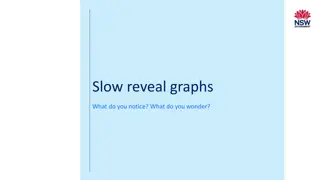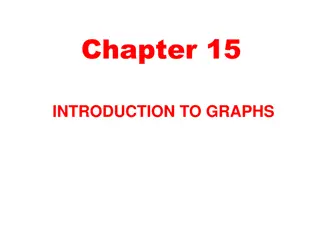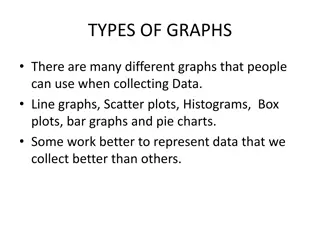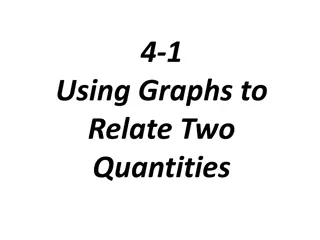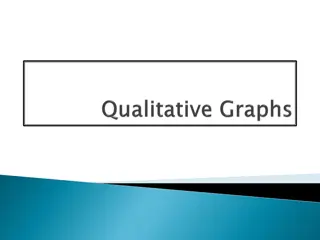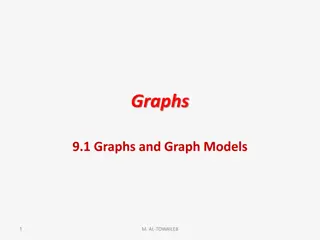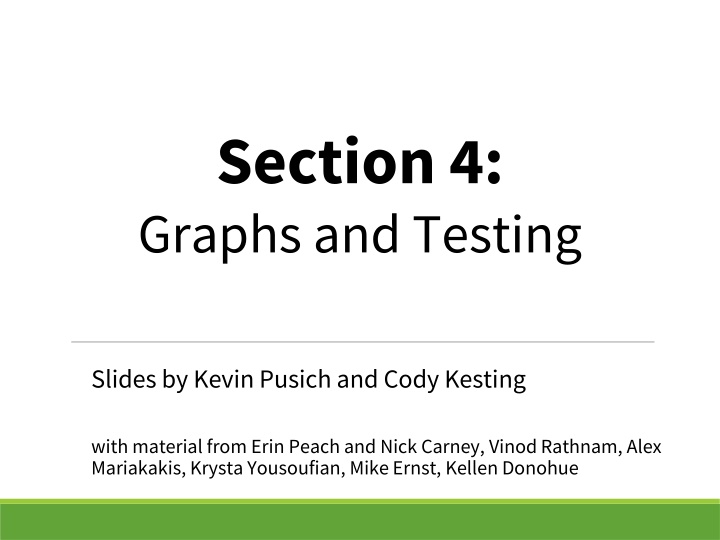
Understanding Graphs: Nodes, Edges, and Paths
Explore the fundamentals of graphs, including nodes, edges, directed and undirected graphs, useful examples, and paths from one node to another. Learn about different types of edges and their applications in various scenarios.
Download Presentation

Please find below an Image/Link to download the presentation.
The content on the website is provided AS IS for your information and personal use only. It may not be sold, licensed, or shared on other websites without obtaining consent from the author. If you encounter any issues during the download, it is possible that the publisher has removed the file from their server.
You are allowed to download the files provided on this website for personal or commercial use, subject to the condition that they are used lawfully. All files are the property of their respective owners.
The content on the website is provided AS IS for your information and personal use only. It may not be sold, licensed, or shared on other websites without obtaining consent from the author.
E N D
Presentation Transcript
Section 4: Graphs and Testing Slides by Kevin Pusichand Cody Kesting with material from Erin Peach and Nick Carney, Vinod Rathnam, Alex Mariakakis, Krysta Yousoufian, Mike Ernst, Kellen Donohue
Agenda Graphs (HW 5) JUnit Testing Test Script Language JavaDoc
Graphs Node Edge
Graphs Node + data item in a graph Edge + connection between two nodes
Graphs Directedgraph: edges have a sourceand destination Edges represented with arrows Parent/child nodes: related by an edge
Graphs collection of nodes (vertices) and edges Nodes: states or objects within the graph Edges: connection between two nodes B A C D E
Graphs Edges can be: A B Directed Undirected C D What are some examples where each type of edge would be useful?
Graphs Directed: Flight itinerary Class dependencies Undirected: Facebook friends Computer networks Seattle John Sally Z rich * Common term: Directed Acyclic Graph (DAG)
Graphs B A Children of A? C D E
Graphs A B Children of A: nodes reached by an edge starting at node A C D E
Graphs A B Parents of D? C D E
Graphs A B Parents of D: nodes that have an edge ending at node D C D E
Graphs Paths from A to C: a sequence or ordered list of edges starting at A and ending at C B A C D E
Graphs Paths from A to C: B A A C C D A D E C Shortest path from A to C? E
REMINDER: You ve seen Graphs before! Linked Lists Binary Trees Luke A B C Leia Droids C3PO R2-D2
Before we move on... Read the wikipedia article in the spec! (It has implementation hints!)
Internal vs. external Internal : JUnit + How you decide to implement the object + Checked with implementation tests External: test script + Your API and specifications + Testing against the specification + Checked with specification tests
A JUnit test class A method with @Testis flagged as a JUnit test All @Testmethods run when JUnit runs import org.junit.*; import static org.junit.Assert.*; public class TestSuite { @Test public void Test1() { }
Using JUnit assertions Verifies that a value matches expectations assertEquals(42, meaningOfLife()); assertTrue(list.isEmpty()); If the assert fails: + Test immediately terminates + Other tests in the test class are still run as normal + Results show details of failed tests (We ll get to this later)
Using JUnit assertions Assertion assertTrue(test) assertFalse(test) assertEquals(expected, actual) assertSame(expected, actual) assertNotSame(expected, actual) assertNull(value) assertNotNull(value) Case for failure the boolean test is false the boolean test is true the values are not equal the values are not the same (by ==) the values are the same (by ==) the given value is not null the given value is null And others: https://junit.org/junit4/javadoc/4.11/org/junit/Assert.html Each method can also be passed a string to display if it fails: assertEquals("message", expected, actual)
USING JUNIT ASSERTIONS When writing JUnit assertions, make sure to use the appropriate test Ex: Testing Java s List.size() Use assertEquals(list.size(), 1) Don t use assertTrue(list.size() == 1)
Checking for exceptions Verify that a method throws an exception when it should: Passes only if specified exception is thrown Only time it s OK to write a test without a form of asserts @Test(expected=IndexOutOfBoundsException.class) public void testGetEmptyList() { List<String> list = new ArrayList<String>(); list.get(0); }
Setup and teardown Methods to run before/after each test case method is called: @Before public void name() { ... } @After public void name() { ... } Methods to run once before/after the entire test class runs: @BeforeClass public static void name() { ... } @AfterClass public static void name() { ... }
Setup and teardown public class Example { List empty; @Before public void initialize() { empty = new ArrayList(); } @Test public void size() {...} @Test public void remove() {...} }
Ground rules 1. Don t Repeat Yourself Use constants and helper methods 2. Be Descriptive Take advantage of message, expected, and actual values Ex: testAddElementToEmptyList instead of testAdd 3. Keep Tests Small Isolate bugs one at a time; failing assertion halts test Helps to catch bugs at the source 4. Be Thorough Test big, small, boundaries, exceptions, errors 5. Order of Testing Matters If methodB() relies on methodA() to work correctly, test methodA() first
Lets put it all together! public class DateTest { // Test addDays when it causes a rollover between months @Test public void testAddDaysWrapToNextMonth() { Date actual = new Date(2050, 2, 15); actual.addDays(14); Date expected = new Date(2050, 3, 1); assertEquals("date after +14 days", expected, actual); }
How to create JUnit test classes Right-click hw5.test -> New -> JUnit Test Case Important: Follow naming guidelines we provide Demo
JUnit asserts vs. Java asserts We ve just been discussing JUnit assertions so far Tests for incorrect behavior Java itself has assertions Tests for invalid states public class LitterBox { ArrayList<Kitten> kittens; public Kitten getKitten(int n) { assert(n >= 0); return kittens(n); } }
Reminder: Enabling asserts in Eclipse To enable asserts: Go to Run -> Run Configurations -> Arguments tab -> input -ea in VM arguments section
Expensive CheckReps ant validate and staff grading will have assertions enabled But sometimes a checkRep can be expensive For example, looking at each node in a Graph with a large number of nodes This could cause the grading scripts to timeout
Expensive CheckReps Before your final commit, remove the checking of expensive parts of your checkRep or the checking of your checkRep entirely Example: boolean flag and structure your checkRep as so: private void checkRep() { cheap-stuff if(DEBUG_FLAG) { // or can have this for entire checkRep expensive-stuff } cheap-stuff ...
External tests: Test script language
Test script language Text file with one command listed per line First word is always the command name Remaining words are arguments Commands will correspond to methods in your code
Test script language # Create a graph CreateGraph graph1 # Add a pair of nodes AddNode graph1 n1 AddNode graph1 n2 e1 n1 n2 graph1 # Add an edge AddEdge graph1 n1 n2 e1 # Print the nodes in the graph and the outgoing edges from n1 ListNodes graph1 ListChildren graph1 n1
Test script language # Create a graph CreateGraph graph1 # Add a pair of nodes AddNode graph1 n1 AddNode graph1 n2 e1 n1 n2 graph1 # Add an edge AddEdge graph1 n1 n2 e1 # Print the nodes in the graph and the outgoing edges from n1 ListNodes graph1 ListChildren graph1 n1
Test script language # Create a graph created graph graph1 e1 n1 n2 # Add a pair of nodes added node n1 to graph1 added node n2 to graph1 graph1 # Add an edge added edge e1 from n1 to n2 in graph1 # Print the nodes in the graph and the outgoing edges from n1 graph1 contains: n1 n2 the children of n1 in graph1 are: n2(e1)
How to create specification tests Create .test and .expected file pairs under hw5.test Implement parts of HW5TestDriver + driver connects commands from .test file to your Graph implementation to the output which is matched with .expected file Run all tests by running SpecificationTests.java + Note: staff will have our own .test and .expected pairs to run with your code + Do not hardcode .test/.expected pairs to pass, but instead make sure the format in hw5 instructions is correctly followed
Workflow for Specification Tests Translate commands, apply them to your graph Formats output to match expected output style Return results of commands Read in commands HW5 Test Driver HW5 Test Driver .test file Graph .java .actual file
JavaDoc API Now you can generate the JavaDocAPI for your code Instructions in the Editing/Compiling Handout Demo: Generate JavaDocs Demo steps are in spec


